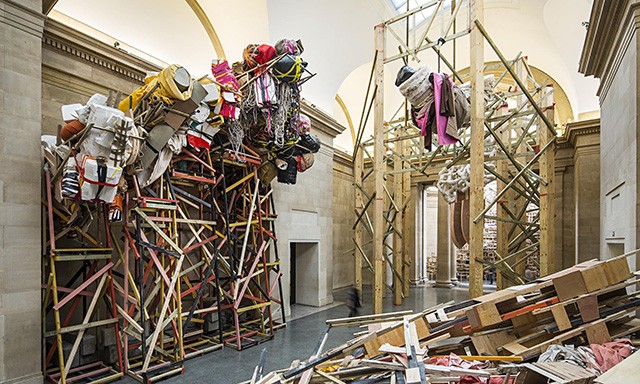
Tate Britain Commission 2014: Phyllida Barlow
The vast, neoclassical Duveen Galleries at Tate Britain aren’t traditionally associated with anarchic, sculptural chaos. Yet septuagenarian British sculptor Phyllida Barlow has managed to achieve this while instilling the galleries with an installation that possesses a crackling, raw energy.
Her installation dock (2014) is an extraordinary sculptural achievement.
Taking London’s docklands as her departure point, as insinuated in the title, the installation fuses reoccurring motifs in Barlow’s work; suspended cylinders, wooden structures, towering cardboard columns, to form an abstract take on the bustle of industrial docklands, both past and present. It surely isn’t coincidence that you can spy Barlow’s Untitled (Yellow Rack) (2006) in the adjacent room of the main Tate hang.
For such material looseness – and seeming precariousness – the execution of Barlow’s work is flawless. It is chaos, but highly controlled and purposeful. Her endless roster of materials are stacked, hung, nailed, balanced and placed in perfect raw symmetry; it all fits together like pieces of a well-oiled, dominant machine. Rather similar to a dock then.
Phyllida Barlow dock (2014)
Barlow’s use of low-fi, cheap materials reinforces the experimental and contradictory nature of her work. In the middle of the gallery, the rising wooden structure, reminiscent of a thousand redundant school desks, is clearly a highly complex feat of construction: you wonder how many individual screws were used?
Yet to dwell on these trivial questions detracts from the sheer inventiveness that crashes over the installation like great waves. Barlow’s unmonumental installations spatially batters the traditional architecture of the Duveens, enveloping the viewer in a series of energetic interventions. There is little room to catch your breath as you weave amongst the structures.
I spent nearly an hour exploring dock’s spatial nooks and crannies, admiring its raw aesthetic and splendid material discoveries. I would argue that the last installation that commanded such authority in Tate Britain was Mike Nelson’s ‘The Coral Reef’ (2000). While Nelson used the Tate’s smaller galleries to weave his complex spatial narrative, Barlow has emphatically made her mark. dock is a career defining work.
